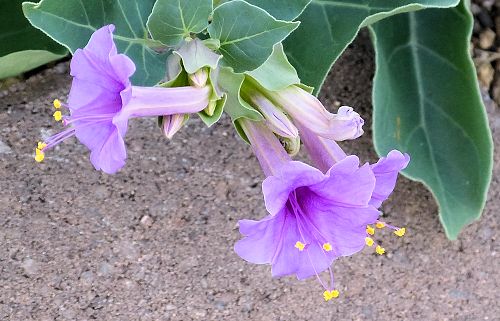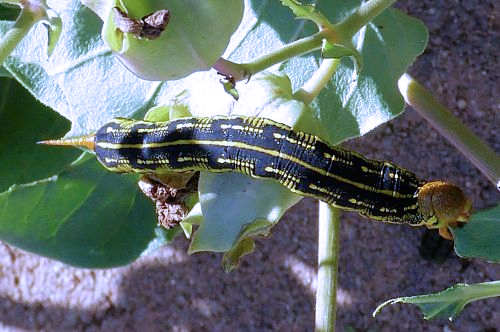Growing Mirabilis multiflora:
Desert Four O'clock
Description
Form: Herb.
Lifespan: A long-lived perennial.
Leaf retention: In winter, this plant dies to the ground. It will also die back in extreme drought.
Growth rate: Moderate to rapid.
Mature Size: 1-2' (30-60cm) high and 3-6' (1-1.8m) in width. After a few years, the plant may cover 15-25 square feet (1.4-2.3 square meters).
Flowers: Vivid purple trumpet flowers, 1" (2.5cm) wide and 2-3" (5-7.6cm) long, are composed of colored, fused bracts, because the plants in this family have no petals. The flowers produce a sweet, musky fragrance at night. Flower buds occur in clusters of six to eight.
Bloom: Several blooming cycles occur in spring, summer and fall in response to rain. Many flowers bloom at once, often over the entire plant. The flowers open late afternoon and close early morning in full sun. A cloudy day will cause earlier opening and later closing. If the flowers have not been pollinated at night, they may stay open later in the morning to take advantage of bees and other daytime pollinators.
Fruit: Seeds held in a papery capsule formed by dried bracts.
Leaves: Green, ovate with a pointed tip, at times nearly heart shaped.
Stems: The stems break off at ground level during winter die back, leaving no trace as to the location of the underground tuber. The leaves and many-branched stems also turn white after winter die back, with the dried stems resembling white balsa wood.
Roots: A deep tuber growing larger and deeper every year. Desert Four O'clock is extremely difficult to transplant.
Wildlife: The flowers attract sphinx moths; their caterpillars consume the leaves. Rabbits eat newly emerged leaves in late winter and early spring before tastier plants appear. This plant develops sooner in the spring when it is protected from rabbits.
Toxic / Danger: All parts are poisonous.
Origin: Southwestern United States and Mexico.
Form: Herb.
Lifespan: A long-lived perennial.
Leaf retention: In winter, this plant dies to the ground. It will also die back in extreme drought.
Growth rate: Moderate to rapid.
Mature Size: 1-2' (30-60cm) high and 3-6' (1-1.8m) in width. After a few years, the plant may cover 15-25 square feet (1.4-2.3 square meters).
Flowers: Vivid purple trumpet flowers, 1" (2.5cm) wide and 2-3" (5-7.6cm) long, are composed of colored, fused bracts, because the plants in this family have no petals. The flowers produce a sweet, musky fragrance at night. Flower buds occur in clusters of six to eight.
Bloom: Several blooming cycles occur in spring, summer and fall in response to rain. Many flowers bloom at once, often over the entire plant. The flowers open late afternoon and close early morning in full sun. A cloudy day will cause earlier opening and later closing. If the flowers have not been pollinated at night, they may stay open later in the morning to take advantage of bees and other daytime pollinators.
Fruit: Seeds held in a papery capsule formed by dried bracts.
Leaves: Green, ovate with a pointed tip, at times nearly heart shaped.
Stems: The stems break off at ground level during winter die back, leaving no trace as to the location of the underground tuber. The leaves and many-branched stems also turn white after winter die back, with the dried stems resembling white balsa wood.
Roots: A deep tuber growing larger and deeper every year. Desert Four O'clock is extremely difficult to transplant.
Wildlife: The flowers attract sphinx moths; their caterpillars consume the leaves. Rabbits eat newly emerged leaves in late winter and early spring before tastier plants appear. This plant develops sooner in the spring when it is protected from rabbits.
Toxic / Danger: All parts are poisonous.
Origin: Southwestern United States and Mexico.
Cultivation and Uses
USDA hardiness zones: 5-10.
Heat tolerant: Yes.
Drought tolerant: Yes.
Sun: Full sun to part shade. This plant performs best in part shade in hot desert regions.
Soil: Well draining, dry, low organic content, 5.6-8.5 (acidic to alkaline).
Water once established: Unnecessary. Watering may result in wildlife browsing unless the plant is protected by a fence. While this plant can withstand water as often as twice a week, it does not need irrigation more than once every week or two to maintain appearance. It can survive without supplemental water once it has been in the ground three years or more.
[1] After new flowers have stopped being produced and all flowers have died, new bloom flushes may possibly be induced by not watering again for 6-8 weeks until all seed capsules have dried and produced mature seeds. [2] At that point, deep watering for 2-4 hours once a week may induce new blooms. If blooming begins again, [3] water weekly during flower production. Repeat steps 1-3 if successful.
Litter: Low except at the start of winter, or in the middle of a severe drought, when it dies to the ground. The dead leaves and stems should be collected and discarded to avoid a scattered trash appearance in the garden.
Propagation: Seed. Scarify the seed before planting.
Uses: Ornamental.
USDA hardiness zones: 5-10.
Heat tolerant: Yes.
Drought tolerant: Yes.
Sun: Full sun to part shade. This plant performs best in part shade in hot desert regions.
Soil: Well draining, dry, low organic content, 5.6-8.5 (acidic to alkaline).
Water once established: Unnecessary. Watering may result in wildlife browsing unless the plant is protected by a fence. While this plant can withstand water as often as twice a week, it does not need irrigation more than once every week or two to maintain appearance. It can survive without supplemental water once it has been in the ground three years or more.
[1] After new flowers have stopped being produced and all flowers have died, new bloom flushes may possibly be induced by not watering again for 6-8 weeks until all seed capsules have dried and produced mature seeds. [2] At that point, deep watering for 2-4 hours once a week may induce new blooms. If blooming begins again, [3] water weekly during flower production. Repeat steps 1-3 if successful.
Litter: Low except at the start of winter, or in the middle of a severe drought, when it dies to the ground. The dead leaves and stems should be collected and discarded to avoid a scattered trash appearance in the garden.
Propagation: Seed. Scarify the seed before planting.
Uses: Ornamental.
Comments
This plant is a member of the Four O'clock family (Nyctaginaceae). Other common names are Colorado Four O'clock, Showy Four O'clock, and Desert Four O'clock.
Do you have additional information or a different experience for these plants that you would like to share? Email info@GardenOracle.com. All contributions are welcome and appreciated.
This plant is a member of the Four O'clock family (Nyctaginaceae). Other common names are Colorado Four O'clock, Showy Four O'clock, and Desert Four O'clock.
Do you have additional information or a different experience for these plants that you would like to share? Email info@GardenOracle.com. All contributions are welcome and appreciated.



A White-Lined Sphinx Moth (Hyles lineata) and its caterpillar

Latest update: March, 2021
© 2008-2025 by GardenOracle.com

